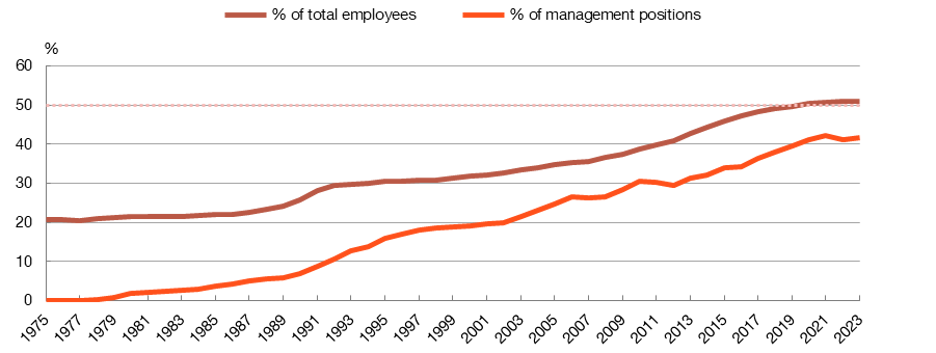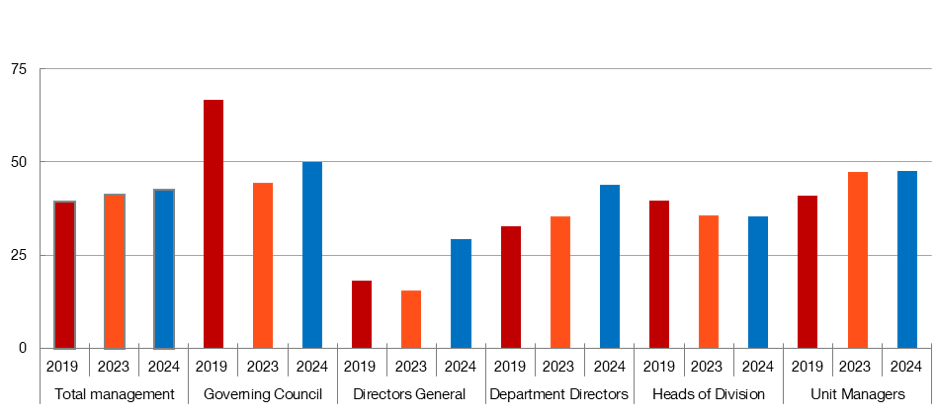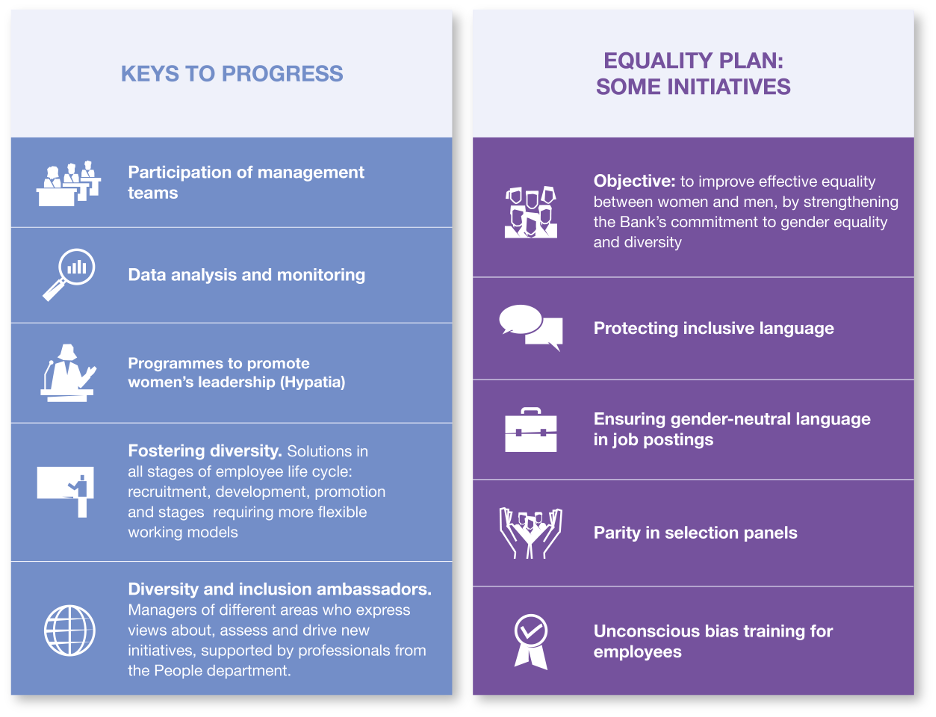What’s left of the glass ceiling? Women’s career advancement at the Banco de España
Women now account for just over half of the Banco de España’s employees. We’ve also made considerable headway in management positions in recent years, all because of an ambitious agenda that promotes equal opportunities. Even so, we have not yet fully closed the gender gap.
07/03/2025
“At the Bank we want to reflect the plural society we serve by promoting equal opportunities while respecting our idiosyncrasies and differences so that all staff members feel included.”
Banco de España, Diversity and Inclusion Manifesto
Remarkable progress has been made in recent years towards gender balance at work. But there is still some way to go. The persistence of the glass ceiling![]() for women in the corporate world is evident. The Banco de España's commitment to the inclusion and equality of all its employees has enabled us to narrow the gender gap considerably in recent years. What is the proportion of women in our workforce? And in our management positions? What are we doing at the Banco de España to promote equality and inclusion at work? What challenges remain?
for women in the corporate world is evident. The Banco de España's commitment to the inclusion and equality of all its employees has enabled us to narrow the gender gap considerably in recent years. What is the proportion of women in our workforce? And in our management positions? What are we doing at the Banco de España to promote equality and inclusion at work? What challenges remain?
Parity in management positions. What do the numbers tell us?
Gender parity has practically been attained at the Banco de España, as shown in Chart 1. This was achieved in 2019, following a steady rise of 30 points in the percentage of women over the last fifty years.
Chart 1
THE PROPORTION OF WOMEN AT THE BANCO DE ESPAÑA HAS RISEN STEADILY, ALSO IN TERMS OF MANAGEMENT POSITIONS

SOURCE: Banco de España.
Parity is also a fact in the top positions of the Bank: the Governor is male and the Deputy Governor is female. The same is true of our main decision-making body: five out of the ten members of the Governing Council are women. In fact, the number of women in decision-making bodies is relatively high compared with other central banks![]() .
.
Nonetheless, if we shine a light on all positions of responsibility, parity has still not been achieved. At end-2024, men occupied 57% of these posts, compared with 43% of women, as shown in Chart 2, although the figures vary considerably across the different areas of the Bank. The biggest differences are in senior management (directors general and associate directors general) where women represented 29% in contrast with the lowest level of management (unit managers) where, with 47%, parity has almost been reached.
Filling management posts with women does not seem to be a problem of availability, given that women have made up around 50% of experts and specialists since 2019. Lastly, the majority of administrative staff are women.
Chart 2
PROPORTION OF WOMEN IN MANAGEMENT POSITIONS

SOURCE: Banco de España.
NOTE: Total management positions is the sum of the categories shown in the chart. The Governing Council refers to members with voting rights. Directors General (DGs) include Associate DGs. Department Directors include Deputy Directors.
Women make up more than half of the Banco de España’s employees, but still only 43% of management positions, despite the progress made in recent years
That said, the proportion of women in management positions has increased in recent years. Overall, the representation of women has only expanded from 39% to 43% since 2019, but there has been a notable leap in the higher spheres, especially in the last year: the percentage of female directors general and associate directors general has almost doubled to 39% and female directors and deputy directors have risen from 35% to 44%.
This is the snapshot of management positions, but to get there women have to compete in professional promotion processes. Are there any gender differences in this area at the Banco de España? To answer this question, researchers at the Bank have collaborated with the People Department and created a database containing individual anonymised information![]() . This database includes the employment history of employees, excluding senior management, with information on the hiring, selection and promotion processes in which they have participated since 2013.
. This database includes the employment history of employees, excluding senior management, with information on the hiring, selection and promotion processes in which they have participated since 2013.
DID YOU KNOW...? There are three paths to professional promotion at the Banco de España:
1. Vertical promotions that entail an increase in salary and level and are assigned directly to certain employees annually without a change in their functions.
2. Direct appointments to positions of responsibility.
3. Open competitions to cover all types of positions.
Analysis of this information![]() – which is made available to the public, in a transparency exercise – found that, on average, there was no significant gender gap in the probability of promotion. The percentage of women who are promoted is not substantially different from the percentage of potential female candidates.
– which is made available to the public, in a transparency exercise – found that, on average, there was no significant gender gap in the probability of promotion. The percentage of women who are promoted is not substantially different from the percentage of potential female candidates.
Again, the gender gap is wider where management positions are concerned. Women are less likely to be promoted to the positions of department director and head of division in selection processes. Moreover, they are less likely to apply for these positions, as has also been observed at the European Central Bank (ECB)![]() .
.
According to the Banco de España’s findings (see Chart 3), a gender gap still exists, with women accounting for a lower share of actual applicants and promoted candidates (around 30%) than of potential candidates for promotion (close to 40%). This means that one of the reasons why there is a lower presence of women in management positions is that fewer women apply than those who could potentially do so.
Chart 3
PROPORTION OF WOMEN IN SELECTION PROCESSES FOR DEPARTMENT DIRECTORS AND HEADS OF DIVISION

SOURCE: Banco de España.
The study also shows that, in the departments with the highest concentration of economists, women who are unit managers (the lowest management level) are more likely to get vertical promotions, which come with an increase in salary but no change in their functions. Their work is seemingly rewarded, but this recognition does not entail a move up the job ladder.
As for why this gender inequality persists, there may be non-work related reasons (as discussed in a previous post![]() ) that are preventing the gender gap from being closed and are obstructing women from breaking through the increasingly fragile glass ceiling.
) that are preventing the gender gap from being closed and are obstructing women from breaking through the increasingly fragile glass ceiling.
What is the Banco de España doing to promote gender equality?
Our progress towards gender equality is underpinned by a comprehensive strategy, outlined in Figure 1.
Figure 1
THE BANCO DE ESPAÑA’S GENDER STRATEGY

SOURCE: Banco de España.
Our progress towards gender equality is underpinned by a comprehensive strategy, anchored in our commitment to diversity and inclusion
The Banco de España has an Equality Plan![]() (only available in Spanish) whose primary objective is to achieve effective equality between women and men. One of the 23 initiatives in this Plan is the “Hypatia” programme for women’s leadership
(only available in Spanish) whose primary objective is to achieve effective equality between women and men. One of the 23 initiatives in this Plan is the “Hypatia” programme for women’s leadership![]() , aimed at narrowing the aforementioned gender gap in management positions.
, aimed at narrowing the aforementioned gender gap in management positions.
More generally, managing diversity in the workplace has, over the years, become an important strategy for the Banco de España. Several initiatives have been designed to harness the potential of a diverse workforce, shape a workplace with equal opportunities and foster a sense of inclusivity among all teams. These are cornerstones of the Eurosystem![]() – of which the Banco de España forms part – as reflected in the Equality, Diversity and Inclusion Charter
– of which the Banco de España forms part – as reflected in the Equality, Diversity and Inclusion Charter![]() . The Banco de España's manifesto at the start of this post is in line with this initiative.
. The Banco de España's manifesto at the start of this post is in line with this initiative.
All these measures help reinforce the Banco de España’s commitment to diversity and inclusion. More plural and inclusive institutions do better and reflect the diverse society they serve. Our goal is to forge ahead with this agenda and to continue building stronger teams with a diversity of talent that will contribute to successfully fulfilling our mandate![]() .
.



